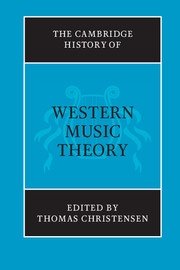Book contents
- Frontmatter
- Introduction
- PART I DISCIPLINING MUSIC THEORY
- PART II SPECULATIVE TRADITIONS
- PART III REGULATIVE TRADITIONS
- A Mapping tonal spaces
- B Compositional Theory
- C Time
- 20 The evolution of rhythmic notation
- 21 Theories of musical rhythm in the eighteenth and nineteenth centuries
- 22 Rhythm in twentieth-century theory
- D Tonality
- PART IV DESCRIPTIVE TRADITIONS
- Index of authors
- Index of subjects
- References
20 - The evolution of rhythmic notation
from C - Time
Published online by Cambridge University Press: 28 March 2008
- Frontmatter
- Introduction
- PART I DISCIPLINING MUSIC THEORY
- PART II SPECULATIVE TRADITIONS
- PART III REGULATIVE TRADITIONS
- A Mapping tonal spaces
- B Compositional Theory
- C Time
- 20 The evolution of rhythmic notation
- 21 Theories of musical rhythm in the eighteenth and nineteenth centuries
- 22 Rhythm in twentieth-century theory
- D Tonality
- PART IV DESCRIPTIVE TRADITIONS
- Index of authors
- Index of subjects
- References
Summary
It is difficult to exaggerate the importance of rhythmic notation to the early history of Western art music. While the early chant repertories were by no means sung uniformly with even note values, our understanding of their rhythmic performance must remain speculative given the lack of any form of secure rhythmic notations. It was only in the thirteenth century that musicians in Paris first established a rudimentary notation to indicate rhythmic patterns using a system of six rhythmic “modes.” Over the next two centuries, as musical culture gradually evolved from one that was largely oral to one that was written, more precise rhythmic notations were developed to accommodate the increasingly complex polyphonic innovations of musicians. At the same time, though, it must not be overlooked that the development of increasingly precise rhythmic notations contributed to these innovations by allowing composers greater stylistic freedom. A good example can be seen in the emergence of the isorhythmic motet, which could not have come into existence without the development of new rhythmic notations. The principal innovation here was the “mensural” system by which ever more complex rhythmic relationships, allowing for duple or triple subdivisions of note values, could be expressed within the duration of a given unit of time. In the late fourteenth and early fifteenth centuries, rhythmic possibilities were further augmented through the use of a system of proportions. Eventually, however, a profusion of competing notational systems led to widespread confusion that the great theorist-reformer Tinctoris tried to eliminate in the late fifteenth century, although with only partial success.
- Type
- Chapter
- Information
- The Cambridge History of Western Music Theory , pp. 628 - 656Publisher: Cambridge University PressPrint publication year: 2002
References
- 3
- Cited by



